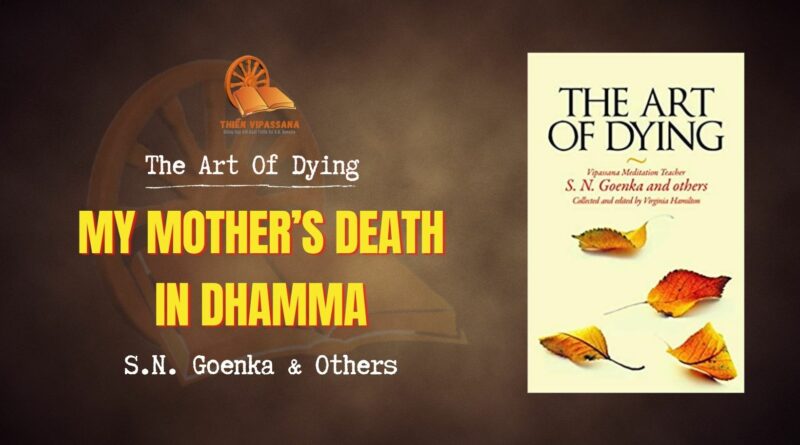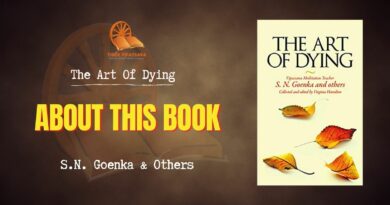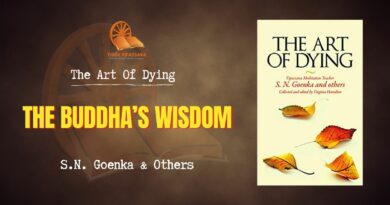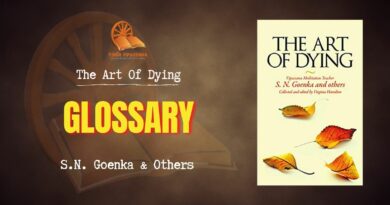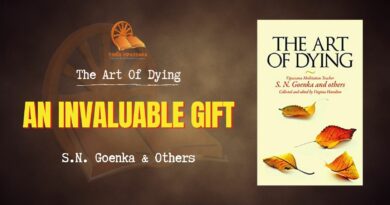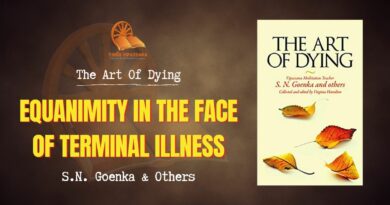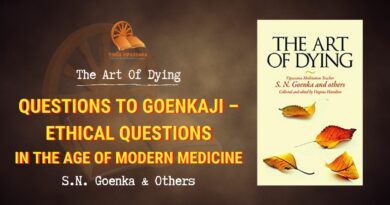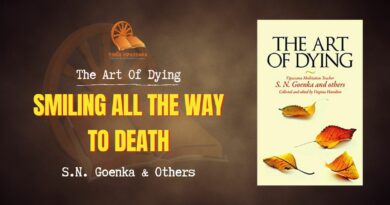My Mother ’s Death in Dhamma
In 1985 a student asked Goenkaji whether it is possible to feel sensations at the time of death. In reply, he related the following story about his adoptive mother’s death (previously published in the April 1992 issue of the Vipassana Newsletter).
I am one of six sons. I was adopted at a young age by my uncle and aunt, Mr. Dwarkadas and Mrs. Ramidevi Goenka, who at the time had six daughters but no son.
My adoptive mother was a devoted student of my teacher Sayagyi U Ba Khin. She made great progress in her years of practicing Vipassana under Sayagyi’s guidance, and Sayagyi was quite fond of her. As far as is known, she was the only student of Sayagyi to die in his presence.
In 1967, when my mother was about 70 years old, she was diagnosed with an advanced stage of liver cancer. We in the family did not know how long she had suffered because she never complained. It was only a week before her death that she casually spoke about some pain in the area of her liver. When her daughter-in-law (my wife, Mrs. Goenka) asked her to describe the pain, she replied, “Well, the pain is similar to what a mother suffers when she gives birth—except this has no break.”
By then she had been meditating very seriously for seven years. She went to the meditation center every time there was a course, whether for 10 days, one month, or any other period. Her bag was always packed. She also did self-courses at home. Although she came from a devout Hindu background, she was no longer interested in rites and rituals; she had left them behind.
From the time she was diagnosed with cancer until she died seven days later, she would not allow anyone to talk to her about her disease. She gave strict orders that only Vipassana meditators were to come into her room, and then only to meditate. They could meditate for a half hour, an hour or many hours, and then were to leave quietly.
In our Hindu community it was customary for the friends of a dying person to come to the house to pay respects. My mother was very popular and she had many people wishing to visit her in her final illness. For those who were not meditators, she gave instructions that they were welcome to visit but not come into her room. They could sit quietly outside her door.
My mother was not interested in receiving treatment, but as her son it was my duty to arrange it for her. Every day our family doctor and a specialist visited her. When they questioned her about her pain she said, “Yes, there is pain. So what? Anissa, anissa (the Burmese pronunciation of the Pāḷi word anicca— impermanence).” She attached no importance to it.
One morning the specialist was concerned that the pain of the cancer might be interfering with her sleep. When he asked, “Did you sleep soundly last night?” she answered, “No, I had no sleep.” He wrote a prescription for some sleeping pills that she took that night. The next day the doctor came and asked if she had slept, and she replied, “No.” Again on the third day he asked, and again she responded, “No.”
Even though she did not complain, the doctor was worried that she was not sleeping because she was suffering so much. Not knowing, because of drug shortages, which particular medicine would be available, he wrote prescriptions for three different strong sleeping pills intending that only one pill be purchased. However, all three were available and bought, and by mistake she was given a triple dose. Once more the next morning she reported that, although her eyelids had become heavy, she had not slept all night.
It then occurred to me that the doctor did not understand. To a Vipassana meditator sleep is unimportant, especially on one’s deathbed. Despite sedation, my mother’s strong determination had kept her alert. She had been practicing Vipassana every moment. I explained to the doctor that sleeping pills would not help, but he couldn’t comprehend. He said, “I have given her this strong medicine and even it does not help her sleep. That must mean that she is in great pain.” “It’s not the pain,” I replied. “It is Vipassana that is keeping her awake, aware of her sensations.”
As we came out of her room he remarked, “There is something special about your mother. A woman of the same age in a neighboring house also has liver cancer. She is in great misery and cries out in pain. We feel so sorry to see her in this wretched condition, but cannot console her. And here is your mother who, when we come, just smiles.”
The night she died, some family members were meditating with her. About 11 pm she said to us, “It’s late. All of you go to sleep now.” About midnight the nurse who was on duty noticed that there was no pulse in her wrists. She became worried and, thinking death was near, asked, “May I awaken your children?” “No, no,” my mother answered. “My time has not yet come. When it does, I will tell you.” At 3 am she told the nurse, “Now is the time. Awaken all the family members. I have to go now.”
And so we were all awakened. We came and discovered there was no pulse in many parts of her body. We telephoned Sayagyi and the family doctor, who both came quickly. When the doctor arrived, he said she had only a few minutes left.
Sayagyi arrived shortly thereafter. My mother was lying on her back. There was no pulse in her wrists, as in death, but as soon as she saw her teacher she found the strength to raise her hands and fold them together, paying respect to him.
About five minutes before she died she looked at me and said, “I want to sit.” I turned to the doctor who advised, “No, in a few minutes she is going to die; let her die peacefully. If you move her, her death will be painful. She is already suffering; leave her.” She heard what he said but again told me, “No, let me sit.” I thought, “This is her last wish. She doesn’t care about the pain, so what the doctor says is unimportant. I must help her sit.”
I placed some pillows at her back. With a jerk she sat erect in a meditation position with folded legs and looked at all of us. I asked her, “Do you feel sensations? Do you feel anissa?” She raised her hand and touched the top of her head. “Yes, yes, anissa.” She smiled … and in half a minute she died. In life her face was always aglow. In death, too, there was a radiant glow on her face.
—S.N. Goenka
Soon after his mother’s death Goenkaji left Burma to bring the teaching of the Buddha back to India, the land of Buddha’s birth. From India, with the help of thousands of Goenkaji’s students, it has spread around the world.
Yogā ve jāyatī bhūri,
ayogā bhūrisaṅkhayo.
Etaṃ dvedhāpathaṃ ñatvā,
bhavāya vibhavāya ca;
Tathāttānaṃ niveseyya,
yathā bhūri pavaḍḍhati.
Truly, from meditation wisdom arises; Without meditation wisdom vanishes.
Knowing this branching path leading to gain or loss, One should conduct oneself so that wisdom may increase.
—Dhammapada 20.282
Bài viết này được trích từ cuốn sách The Art of Dying – Thiền Sư S.N.Goenka và nhiều tác giả khác.

